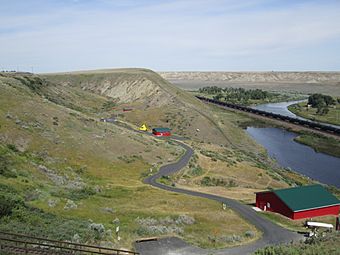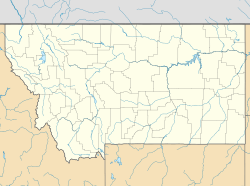Too Close for Comfort Site facts for kids
Quick facts for kids |
|
|
Too Close for Comfort Site (24HL101)
|
|

The Wahkpa Chu'gun Buffalo Jump. The buildings preserve butchering sites and thousands of buffalo bones. The Milk River is in the background.
|
|
| Location | Behind the Wahkpa Chu'gn Meat Market on U.S. Route 2 |
|---|---|
| Nearest city | Havre, Montana |
| Area | 14.5 acres (5.9 ha) |
| NRHP reference No. | 74001098 |
| Added to NRHP | December 30, 1974 |
The Too Close for Comfort Site, also known as Wahkpa Chu'gn, is a special place in Havre, Montana, United States. It is an archaeological site, which means it's a place where scientists study the past by digging up old objects. This site was once a very important buffalo jump.
A buffalo jump was a clever hunting method used by Native American groups for thousands of years. Hunters would guide large herds of buffalo to a cliff edge, causing them to fall. This provided a lot of food and materials for the community.
Contents
Wahkpa Chu'gn: An Ancient Buffalo Jump
Wahkpa Chu'gn is one of the best-preserved buffalo jumps in North America. It shows how ancient people lived and hunted. At this site, archaeologists have found many artifacts. Artifacts are objects made or used by people in the past, like tools, weapons, and pottery. These findings help us understand the daily lives of the people who lived here long ago.
Who Lived at Wahkpa Chu'gn?
Evidence from Wahkpa Chu'gn shows that different Native American groups used this site over many centuries.
- The Besent peoples were the first known group to use the site. They lived here about 2,000 to 1,500 years ago.
- After them, the Avonlea peoples used the site for a short time. This was about 200 to 300 years after the Besent peoples.
- Finally, the Saddle Butte peoples used Wahkpa Chu'gn. They were the last group to use the buffalo jump, continuing until about 600 years ago.
Each group left behind clues about their culture and how they used the land.
Discovering the Past at Wahkpa Chu'gn
The Wahkpa Chu'gn site was first discovered in 1962 by a person named John Brumley. After his discovery, more digging and study, called excavations, took place in the 1960s and 1970s. These excavations were done by groups like the Montana State Archaeological Society.
In the late 1970s, John Brumley took over the excavations again. Then, in 1992, he and his wife started managing the site. They made it a unique place where visitors can experience archaeology firsthand. It's called a "non-sterile" site because it's still being studied and explored, even by visitors.
Visiting Wahkpa Chu'gn Today
Today, Wahkpa Chu'gn is open to the public. It is managed by the H. Earl Clack Memorial Museum. Visiting the site allows you to see the actual layers of history. You can learn about the buffalo jump and the ancient people who used it. It's a great way to connect with the past.
The site was recognized for its historical importance on December 12, 1974. It was added to the National Register of Historic Places. This is a list of places in the United States that are important to the country's history.



